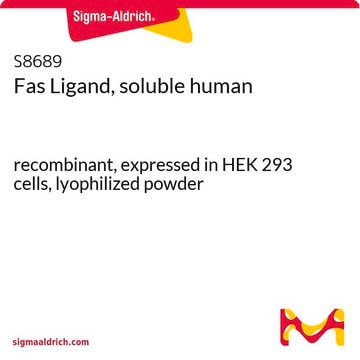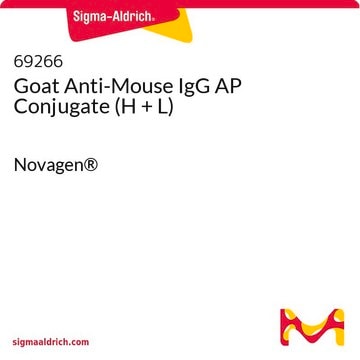F0427
Fas Ligand human
>95% (SDS-PAGE), recombinant, expressed in CHO cells, lyophilized powder
Sinônimo(s):
FasL
Faça loginpara ver os preços organizacionais e de contrato
About This Item
Produtos recomendados
recombinante
expressed in CHO cells
Nível de qualidade
Ensaio
>95% (SDS-PAGE)
forma
lyophilized powder
peso molecular
monomer calculated mol wt ~18 kDa
26-28 kDa by SDS-PAGE
Impurezas
endotoxin, tested
nº de adesão UniProt
temperatura de armazenamento
−20°C
Informações sobre genes
human ... FASLG(356)
Descrição geral
FASLG (Fas ligand) acts as a ligand for Fas receptor, and is a major protein involved in programmed cell death, apoptosis. Soluble Fas (sFAS) is usually detected in plasma prior to apoptosis.
Aplicação
Fas Ligand (FASLG) human has been used for-
- the study of FASLG stimulation in luteal cells obtained from mid-corpus luteum (CL) and
- the study of apoptosis induction and intracellular caspase-3 assay in human cells.
Ações bioquímicas/fisiológicas
FASLG (Fas ligand) and Fas receptor constitute the basic elements in apoptosis. Interaction of FASLG with Fas receptor leads to activation of caspase-8. This caspase in turn leads to activation of effector caspases such as caspase-3, -6 and -7. This cascade results in the hydrolysis of nuclear and cytoplasmic components. Expression of FASLG is induced by nuclear factor-κB (NFκB). NFκB/FASLG pathway facilitates the suppression of p,p′-DDT (dichlorodiphenoxytrichloroethane)-induced cell toxicity by vitamin C and E. In CD4+ T cells, this protein is expressed on stimulus by T-cell receptor (TCR), both during normal and pathological conditions, such as alcohol exposure.
Fas ligand, a protein belonging to the tumor necrosis factor (TNF) family of cytokines, induces apoptosis in cells expressing the cell membrane receptor Fas (CD95/Apo-1).
Outras notas
Human Fas Ligand, N-terminal 6X histidine-tagged, encodes amino acids 134-281.
forma física
Lyophilized from a 0.2 μm filtered solution in phosphate buffered saline containing 0.5 mg bovine serum albumin.
Nota de análise
Measured by its ability to induce apoptosis in Jurkat cells.
Palavra indicadora
Warning
Frases de perigo
Declarações de precaução
Classificações de perigo
Eye Irrit. 2 - Skin Irrit. 2
Código de classe de armazenamento
11 - Combustible Solids
Classe de risco de água (WGK)
WGK 3
Ponto de fulgor (°F)
Not applicable
Ponto de fulgor (°C)
Not applicable
Certificados de análise (COA)
Busque Certificados de análise (COA) digitando o Número do Lote do produto. Os números de lote e remessa podem ser encontrados no rótulo de um produto após a palavra “Lot” ou “Batch”.
Já possui este produto?
Encontre a documentação dos produtos que você adquiriu recentemente na biblioteca de documentos.
Xiaoting Jin et al.
PloS one, 9(12), e113257-e113257 (2014-12-03)
Dichlorodiphenoxytrichloroethane (DDT) is a known persistent organic pollutant and liver damage toxicant. However, there has been little emphasis on the mechanism underlying liver damage toxicity of DDT and the relevant effective inhibitors. Hence, the present study was conducted to explore
Malavika S Giri et al.
Journal of immunology (Baltimore, Md. : 1950), 182(7), 4459-4470 (2009-03-21)
Mechanisms that may allow circulating monocytes to persist as CD4 T cells diminish in HIV-1 infection have not been investigated. We have characterized steady-state gene expression signatures in circulating monocytes from HIV-infected subjects and have identified a stable antiapoptosis gene
Aleksander Szymanowski et al.
Atherosclerosis, 233(2), 616-622 (2014-02-19)
Apoptosis of natural killer (NK) cells is increased in patients with coronary artery disease (CAD) and may explain why NK cell levels are altered in these patients. Soluble forms of Fas and Fas ligand (L) are considered as markers of
Antonio M Galvao et al.
Biology of reproduction, 83(6), 901-908 (2010-08-20)
Proapoptotic factor Fas ligand (FASL) and its cell surface receptor FAS are tumor necrosis factor superfamily members that trigger apoptosis in different cell types. However, their influence on luteal steroidogenesis is not clearly understood. The aim of the present work
Intracellular bacteria engage a STING-TBK1-MVB12b pathway to enable paracrine cGAS-STING signalling.
Ramya Nandakumar et al.
Nature microbiology, 4(4), 701-713 (2019-02-26)
The innate immune system is crucial for eventual control of infections, but may also contribute to pathology. Listeria monocytogenes is an intracellular Gram-positive bacteria and a major cause of food-borne disease. However, important knowledge on the interactions between L. monocytogenes
Nossa equipe de cientistas tem experiência em todas as áreas de pesquisa, incluindo Life Sciences, ciência de materiais, síntese química, cromatografia, química analítica e muitas outras.
Entre em contato com a assistência técnica









